Menus
- Small (Force of) strike !
- Unchanged since 2010, the Yamaha R6 remains a benchmark in the Supersports segment. Light and radical, it is as pleasant on the track as it is weary on the open road…
- Discovery
- On track
- In the city
- Motorways and expressways
- Departmental
- Braking
- Consumption
- Duo
- Conclusion
Small (Force of) strike !
Unchanged since 2010, the Yamaha R6 remains a benchmark in the Supersports segment. Light and radical, it is as pleasant on the track as it is weary on the open road…
Since its introduction to the market in 1999, the Yamaha R6 has positioned itself as one of the most radical machines in the Supersport category.. Twelve years and six developments later, the situation is still the same. The latest development dates back to 2010, improving on points of details the 2008 version. The modifications essentially aim to bring the R6 into line with the anti-pollution standards currently in force with alterations to the airbox, the exhaust. , all accompanied by reprogrammed injection mapping to tune the engine to these new peripherals. By the way, the weight increases by 5 kilos. For the rest, we find the same machine as when it was presented in 2008.
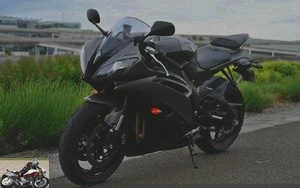
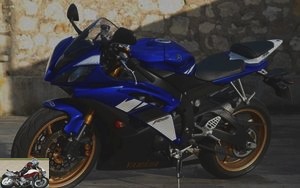
Of course, four is a lot for a Supersport, but the technical characteristics, and above all the technological content, make it a machine that is still relevant today. The 599cc four cylinder is electronically charged with a ride-by-wire accelerator and variable intake varying the length of the intake manifolds to optimize filling in mid-range. Add to that an exhaust valve and an anti-dribble clutch and you have one of the most sophisticated mills in its class..
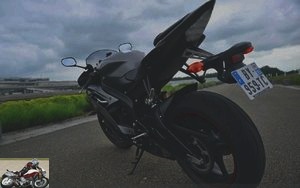
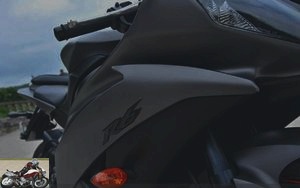
On paper, all these high-tech chips and odds and ends translate into 64 Nm of torque at 11,500 rpm and 135 dynamic horsepower at 14,500 rpm and a breaker kicking into action at stratospheric revs of 17,000 rpm. At least in the free world, with us we have to be content with 58 Nm (but available from 10,500 rpm) and 106 horses all that is more static (so a little more once the air box is in pressure), always at 14,500 rpm.
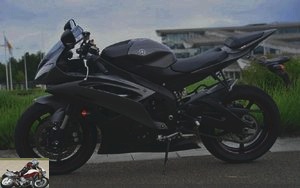
Chassis side is not bad either with an aluminum Deltabox-type frame and a rear buckle made of magnesium. Let’s move on to the peripheral elements, all optimized to offer the best weight and stiffness ratio. Just know that the weight in running order is only 189 kg for this 2012 vintage.
Discovery
On the design side, this Yamaha is sublime in its aggressiveness: gaping air intake between the two headlights, openwork fairing, the rear section sleek and tapered like a scalpel…. The designers at Yamaha clearly went out of their way in designing the R6, especially as the finish, also remarkable, continues to flatter the retina when you get closer..
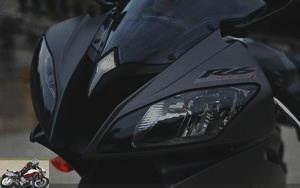
The whole is also remarkably compact, the size approaching that of a sports 400 cm3 (for "old" who know). Yamaha has not skimped on the quality of the running gear either, it is the category that wants that The inverted fork of 41 mm in diameter is adjustable in all directions, as the rear shock absorber, anchored via rods on a swing arm in XXL format. Braking is matched with a dual 310mm front disc clamped by radial 4-piston calipers and actuated by a master cylinder, also radial. Significantly less strained, the rear is content with a simple 220mm disc. The socks are state-of-the-art Bridgestone Battlax S20s in 120/70 front and 180/55 rear. A sporty machine, the dashboard is monastic and ultra-readable with a huge tachometer flanked by two digital blocks and embellished with a shift light. The time and speed are displayed on the left, the engine temperature on the right and, as desired, the total or partial mileage or a stopwatch during incursions on the circuit.
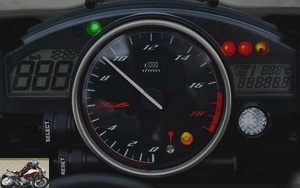
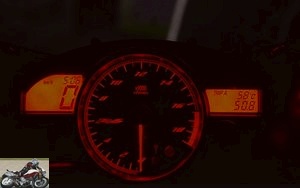
Besides, since we’re talking about it, let’s go !
On track
Do not look for a picture of our R6 when we went to kneel on the ground, our photographer was not available that day…. This is a great pity because being the owner of the previous vintage (2006), he would have measured all the benefits provided by the current generation. Besides, "The R6 is ready to be used on the track without any modification." It’s not me saying it but Takeshi Higuchi, Product Planning Manager for Europe. And for once, this is not a purely marketing discourse but the reality! Copiously tilted forward, the rider feels like he has the front wheel axle directly in his hands. And the saddle, perched 850mm high, will force those under 1.75m to stand on tiptoe. In short, we are not mistaken about the goods, it is radical.
A clutch (not adjustable), first down, let’s go. The 2006 generation was known to be extremely lively, even too much in some cases. None of that here. The front axle with the revised geometry brings more stability in all the phases of piloting and lost this fickle aspect during the strong reaccelerations on the angle. The counterpart is a slight inertia once placed on its trajectory. Without being truckish, the R6 requires fine steering and good anticipation. Because in case of approximation, correcting a trajectory requires muscle. The rest is just happiness.
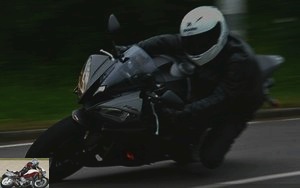
The front end builds confidence, giving the impression of being riveted to the ground. The limited suspension travel and well-controlled hydraulics allow you to pull the brakes hard to the point of chord. Slightly releasing the brake on the angle does not disturb the set, and braking on the angle does not freeze the nose gear. In short, that’s good. With only 106 horsepower, the acceleration is done without a second thought.
The optimum operating range is between 13,000 and 16,000 rpm, but the variable intake offers enough torque below that you don’t get stuck when exiting a corner below this threshold. The gearbox, which is very hard when using the clutch, becomes oddly smoother when you stop using the left lever to upshift. And whatever the rpm, the excellent connection between the accelerator and the rear wheel allows the arrival of the cavalry to be metered to the pony. On degraded sections, acceleration is a little less serene, the train seems a little too braked from the outset in hydraulics, inducing parasitic movements in the steering. In short, the R6 is a weapon, which will require a bit of skill to be fully exploited. The only small regret comes from the braking. Power and bite are there, as is the dosability on very heavy braking. On the other hand, the lever curiously lacks feeling on the first few millimeters of the race, making the dosage a little rough in certain phases of piloting (like a large curve that closes….).
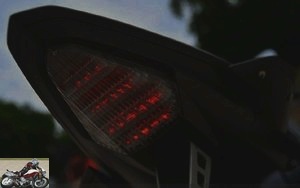
In the city
What is this track beast worth outside of his favorite world? Logically, it is not ecstasy…. Riding on a daily basis in R6 should be reserved for young bikers or those with a particularly well-developed sense of self-sacrifice.

The riding position, with a high saddle of the half-handlebars placed very low, hurts the handles and necks. The hard gearbox (a typical brand defect that can be mitigated by careful break-in) is more eye-catching in the first half of the tachometer. The injection, so soft on the attack, gratifies you with jerks when the low throttle reopens in the towers and the magnificent fairing moreover, directly evacuates all the calories of the engine directly on the legs. Add to that an aircraft carrier steering angle, a congenital defect of the Supersport genre, and a mediocre rearview and you will understand that the R6 can be trying in town and in traffic jams. Too bad because the four cylinders, ultra flexible by nature, is particularly pleasant in intermediate speeds thanks to its variable admission, providing correct revivals from 7,000 revs, even muscular after 8,000 revs..

The work of the suspensions, yet firm type, performs a remarkable job in filtering small shocks at low speed.
Motorways and expressways
The rolling sections of the road are not a punishment for the R6, but here too you have to deal with the very racing orientation of the whole. Despite an ultra racing bubble that only offers anecdotal protection in inclement weather, you have to go around 160 km / h before the wind pressure relieves the pressure on the body on the handles. Not good for the license…. On the other hand, the roundness of the engine is particularly welcome when overtaking. No need to stack two, or even three reports, to overtake a heavyweight on national.
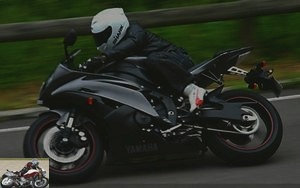
Stalled in sixth at 110 km / h, the 600cc purrs at 6000 revs and all you have to do is retract fifth to take advantage of the extra torque offered by the variable intake. On the motorway, it is even better since it is no longer even necessary to downshift, the tachometer showing only 7,500 rpm at 130 km / h…. And with an average consumption of just over 6 liters (off circuit), the R6 is capable of traveling nearly 270 kilometers before running out of fuel. But rest assured, the hard saddle will make you stop well before the fateful moment..
Departmental
With the caution that is required on open roads, we find here configurations of turns close to those of a circuit. The R6 is therefore at ease there, as long as the bitumen is not too degraded. Better, the constraints being lower, the general rigidity of the chassis fades, finding here a certain capacity for improvisation. Less concentrated on its trajectory and its braking points, we take advantage of the intoxicating sound of the engine.
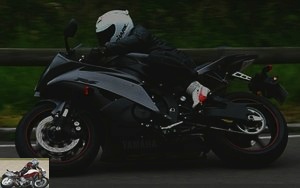
The four cylinder may be the most popular engine architecture today, but it will appeal to music lovers. Anything at low revs, it reveals its true personality when the variable intake kicks in at 8,000 rpm (and probably the valve on the exhaust as well). The sound climbs up a notch, turns treble then treble, all accompanied by a metallic throat clearing so characteristic of R6 blocks.
Braking
Power and bite are there, as is the dosability on very heavy braking. On the other hand, the lever curiously lacks feeling on the first few millimeters of the race, making the dosage a little rough in certain phases of piloting..
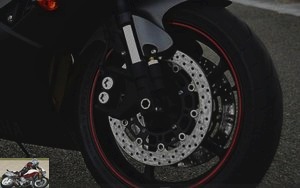
Consumption
With an average consumption of just over 6 liters, the R6 is capable of traveling nearly 270 kilometers before running out of fuel..
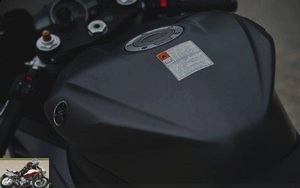
Duo
Seriously? Long sports trips are the ordeal of the nail board and the R6 does not work miracles in this area. In repair, on the other hand, we are better off than on some of its congeners. It doesn’t matter much either. The passenger seat on the surface of a pack of cigarettes and the consistency of a cinder block, and your feet are a few inches from the buttocks. But the compact size means that you can take support from the large tank without lying on the pilot. Suddenly the suspension plays less with the bones with the lumbar and one limits the inevitable blows of helmet during braking. It’s already taken ….
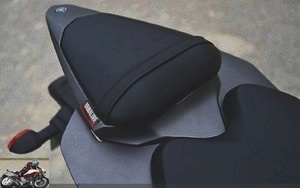
Conclusion
A track beast barely watered down for the road, the Yamaha R6 is, along with the Triumph Daytona 675, one of the most radical and rigorous machines in its class. Those who put up with this radicality will benefit from firm but high-level handling and a characterful engine, a feature that is increasingly rare nowadays in 4 cylinders …. Its Japanese cousins are more livable on a daily basis, especially in terms of the driving position. The R6 is also one of the most expensive, but the price is justified by the above-average finish and on-board technology. The Yamaha hypersportive can now be found in concession at € 12,499, and even € 12,999 in its red and white livery celebrating the 50th anniversary of the brand in tuning forks. The Honda CBR 600 RR is € 10,690 (+ € 1,000 with ABS), the Suzuki GSX-R 600 at € 10,999, the Kawasaki ZX-6R at € 11,999 and the Triumph 675 Daytona at € 11,590. Only the R version of the English is more expensive, with its € 13,390.
Strong points
- Pleasant engine at all speeds
- Track efficiency
- Look and finish
- The couple gain since 2010
Weak points
- Saddle height
- Radical driving position
- Disagreeable gearbox (except on track….)
Competitors: Honda CBR 600 RR, Kawasaki ZX-6R,
MV Agusta F3, Suzuki GSX-R 600,
Triumph Daytona 675
The R6 technical sheet
Related articles
-
Thin blade Single cylinder with variable valve timing, 124.7 cm3, 15 hp and 12.4 Nm, 142 kg, 5,299 euros For several years, small sports cars have made a…
-
Triumph Street Triple 765 RS motorcycle test
The Moto2 roadster 3-cylinder engine, 765 cc, 123 HP, 79 Nm, 166 kg dry, € 11,900 Since its release in 2007, the Street Triple has been a real commercial…
-
Honda CRF 250 L motorcycle test
A little trail that sparkles The great Escape You don’t like small cars? So be sure to read this article! Because after discovering this new Honda, you…
-
2012 Kawasaki ER-6f motorcycle test
Swiss army knife first price While the ER-6n has been a historic bestseller in the Kawasaki lineup since its debut in 2006, its streamlined “f” version…
-
3 cylinders, 847 cm3, 115 hp, 8.9 m / kg, 195 kilos, € 12,599 A limited series of 695 pieces in collaboration with Abarth October 2007: Valentino Rossi…
-
Suzuki GSX-R 600 motorcycle test
Little Queen Revamped this year, the 600 GSXR follows in the footsteps of its big sister 750 cm3 from which it borrows the dress and even all the…
-
The scooter missing between 250 and 530 cm3 in tune XMax 125, XMax 250, TMax 530…. one could have imagined that Yamaha would go hunting on the roads of…
-
2015 vintage Thirteen years since the TMax made its appearance with several major evolutions since the TMax 500 cm3. If the maxi scooter evolves again in…
-
Royal Enfield Meteor 350 motorcycle test
Entry-level, extra class Air / oil single cylinder, 349 cm3, 20 hp and 27 Nm, 191 kg full made, from 4.099 euros Royal Enfield commemorates its 120th…
-
Ducati Monster motorcycle test
Salon revolution V-Twin Testastretta of 937 cm3, 111 hp, 93 Nm, 166 kg dry (188 kg full made), 11,290 euros Is a Monster still a Monster if it doesn’t…
After 2000 km I can conclude:
Very pleasant engine strengths, quiet, torque, controlled sound and nice sound, perfect for the ride but also long journeys. Clutch well, front braking too, very manoeuvrable motorcycle even in town, quite good protection even if the bubble could be 5 cm more. Super road holding. Easy to crutch. Very comfortable mono or duo, very well designed suspension adjustment. Super lighting.
weak points: aesthetic? blah … finish: blah (cables especially, a real mess), medium rear brake, ugly gray stems and not backlit, no turn signal tempo, regulator does not display the requested speed, the quick-shifter rather unpleasant I prefer to use the very soft clutch.